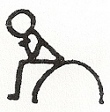THE WAY I REMEMBER IT
In my early years of growing up, I can’t remember ever answering the question, “What do you want to be when you grow up?” by saying. “A truck driver.” For a while, it seemed that way though.
World War II had gotten underway in December of 1941 with the attack on Pearl Harbor . Young men were being drafted into the military as fast as they could be processed. I was fifteen, and in my Junior year of High School. The area between Copperas Cove , Gatesville and Killeen was designated as Camp Hood . Many of the farmers in this area were given only 60-120 days to move out.
Our friends, the Mickans, owned a Cotton Gin, and a semi-truck they used to haul cottonseed to the Oil Mill in Temple . The truck was soon put to work moving families out of the Army Camp area. I began helping Ben Mickan with this activity, and as soon as I turned sixteen, went and obtained a commercial license so that I could drive the truck. It wasn’t much fun, moving people from the land that had, in many cases, been owned by the family for generations, and it was hard work, often day and night. We alternated hauling cottonseed when needed. That wasn’t much fun either since we usually had to load the truck by hand, one seed fork at a time.
After many of the people had been moved, and the cotton season in the fall was over, a change was made. Highway 190 from Belton to Lampasas was being upgraded to serve Camp Hood , and gravel trucks were needed. Through a brother-in-law in Albany , Texas , the Mickans located a used dump bed. Ben and I unhooked the trailer from the cab, and headed to Albany . Two days later we were headed home outfitted as a dump truck. Through the fall of ’42 and during the spring of ’43, I spent a lot of weekends and holidays hauling sand and gravel from the Lampasas River near Kempner to the bridge being constructed over Clear Creek (near Central Texas College), and a lot of road base from the top of the first hill when you head toward Lampasas from Copperas Cove. I can recall one long day hauling 53 loads from the rock crusher on top of the hill to the road- bed near Trinity Lutheran Church .
In May I graduated from High School, and went to California to visit Ben Mickan in California , who was now in the service. I returned in about a month and enrolled in the Summer Session at Texas Tech. At the time I had only $65.00 from my Dad for tuition and books. I needed a job, and took the first thing that came along—working in a machine shop. I soon found out that this was not my calling, and mentioned it to my friend O.O. Shade, who had once worked for grandpa Teinert on the farm. Shade worked for A.B. Ohlenbush, a small oil wholesaler. I had ridden with Shade a few times in one of the gasoline transport trucks, and had driven the truck, with him along, a time or two. Ohlenbush needed a relief driver, and I took the job. One day I would work in his wholesale facility and service station from 4PM to 8PM, and the next day I would make a trip to the refinery at either Rotan or Colorado City from 4 PM to 12 AM. The problem was, the trucks were often not on schedule, and I had some real late nights. I hauled gasoline until I enlisted in the service in January of ’44.
The truck that I drove was affectionately referred to as “the cigar” since it had been made from two regular tank trucks and was really long and skinny. Shortly before I left for Europe I learned that it had rolled over in the middle of Post and burned. Perhaps enlisting in the military wasn’t such a bad idea.
Vic Mathias – August 3, 2005

